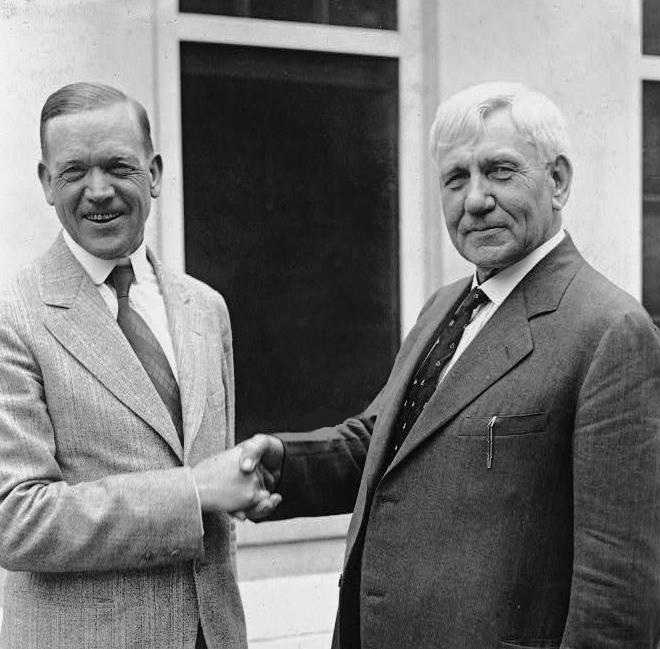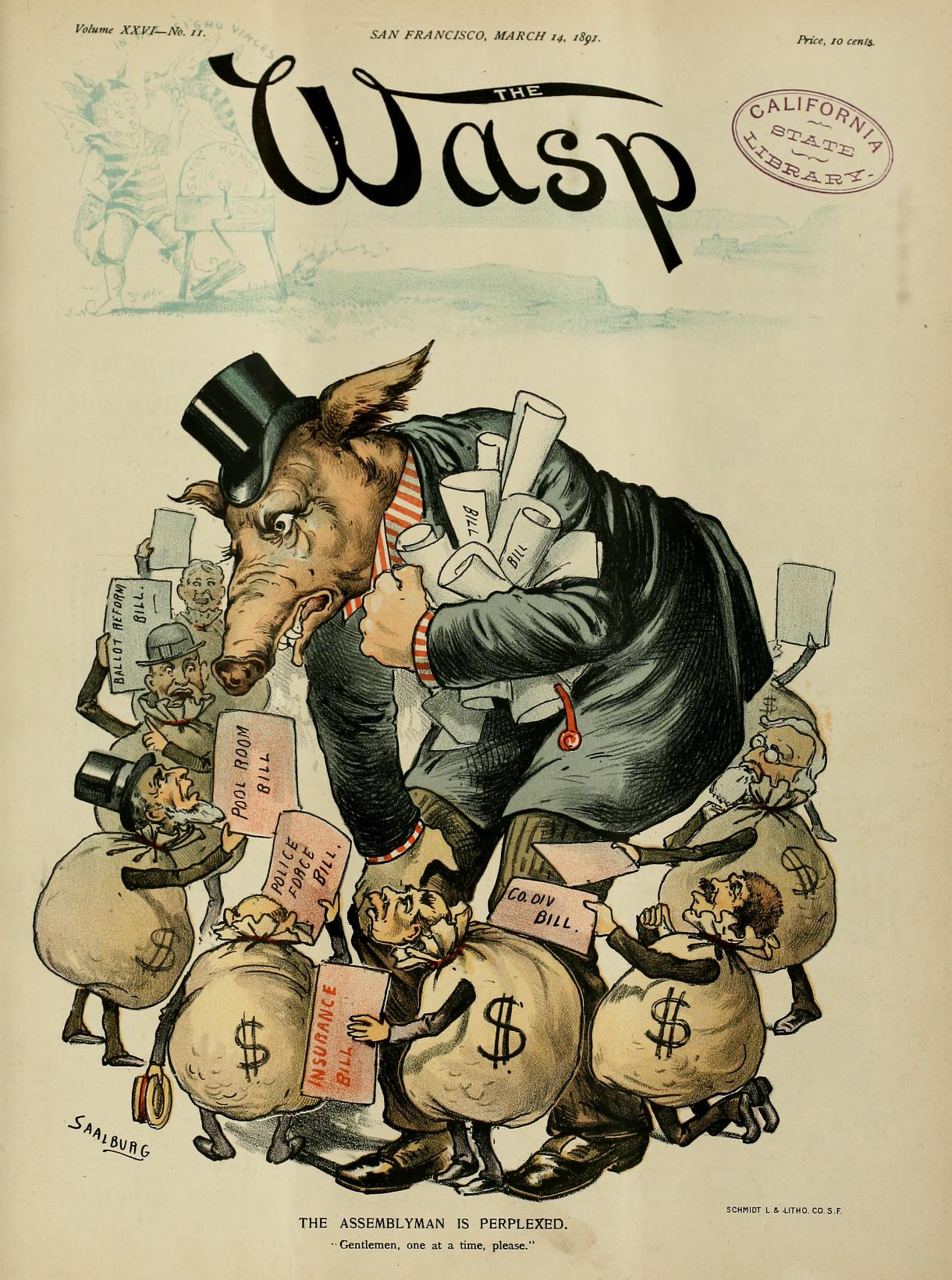|
Cooperative Marketing Act
The Cooperative Marketing Act of 1926 44 Stat. 802 (1926) was a piece of agricultural legislation passed in the United States which expanded upon the Capper–Volstead Act of 1922. It allowed farmers to exchange “past, present, and prospective crop, market, statistical, economic, and other similar information” at their local cooperative meeting, without breaking antitrust laws. Previously, under the Capper–Volstead Act, they had only been permitted to exchange pricing information. Under the Cooperative Marketing Act, farmers and their local, regional, and national cooperatives could legally exchange a host of information within their marketing systems. It was a critically important strategic authorization that enabled federated cooperative systems and marketing agencies-in-common to effectively function as coordinated entities. In addition, the Act created the Division of Cooperative Marketing within the United States Department of Agriculture to assist cooperatives in gath ... [...More Info...] [...Related Items...] OR: [Wikipedia] [Google] [Baidu] |
Capper–Volstead Act
Capper–Volstead Act (P.L. 67-146), the Co-operative Marketing Associations Act (7 U.S.C. 291, 292) was adopted by the United States Congress on February 18, 1922. It gave “associations” of persons producing agricultural products certain exemptions from antitrust laws. It is sometimes called the Magna Carta of cooperatives. Origins The law was passed in response to challenges made against cooperatives using the Sherman Act (15 U.S.C. 1 et seq.), the Clayton Antitrust Act (15 U.S.C. 12 et seq.), and the Federal Trade Commission Act (15 U.S.C. 41 et seq.). As a consequence of the depression of agricultural prices subsequent to World War I, farm organizations intensified their drive for government aid and managed to get a farm bloc established in Congress. Senator Arthur Capper was a member of this bloc and the Capper–Volstead Act was a part of the farm legislative program. (The law carries the names of its sponsors, Senator Arthur Capper of Kansas and Representative Andrew ... [...More Info...] [...Related Items...] OR: [Wikipedia] [Google] [Baidu] |
Competition (economics)
In economics, competition is a scenario where different Economic agent, economic firmsThis article follows the general economic convention of referring to all actors as firms; examples in include individuals and brands or divisions within the same (legal) firm. are in contention to obtain goods that are limited by varying the elements of the Marketing mix for product software, marketing mix: price, product, promotion and place. In classical economic thought, competition causes commercial firms to develop new products, services and technologies, which would give consumers greater selection and better products. The greater the selection of a good is in the market, prices are typically lower for the products, compared to what the price would be if there was no competition (monopoly) or little competition (oligopoly). The level of competition that exists within the market is dependent on a variety of factors both on the firm/ seller side; the number of firms, barriers to entry, infor ... [...More Info...] [...Related Items...] OR: [Wikipedia] [Google] [Baidu] |
Calvin Coolidge
Calvin Coolidge (born John Calvin Coolidge Jr.; ; July 4, 1872January 5, 1933) was the 30th president of the United States from 1923 to 1929. Born in Vermont, Coolidge was a History of the Republican Party (United States), Republican lawyer from New England who climbed up the ladder of Massachusetts state politics, becoming the state's Governor of Massachusetts, 48th governor. His response to the Boston Police Strike of 1919 thrust him into the national spotlight as a man of decisive action. Coolidge was elected the country's 29th vice president of the United States, vice president the next year, succeeding the presidency upon the sudden death of President Warren G. Harding in 1923. Elected in his own right in 1924 United States presidential election, 1924, Coolidge gained a reputation as a small-government Conservatism in the United States, conservative distinguished by a taciturn personality and dry sense of humor, receiving the nickname "Silent Cal". Though his widespread p ... [...More Info...] [...Related Items...] OR: [Wikipedia] [Google] [Baidu] |
Veto
A veto is a legal power to unilaterally stop an official action. In the most typical case, a president or monarch vetoes a bill to stop it from becoming law. In many countries, veto powers are established in the country's constitution. Veto powers are also found at other levels of government, such as in state, provincial or local government, and in international bodies. Some vetoes can be overcome, often by a supermajority vote: in the United States, a two-thirds vote of the House and Senate can override a presidential veto. Article I, Section 7, Clause 2 of the United States Constitution Some vetoes, however, are absolute and cannot be overridden. For example, in the United Nations Security Council, the permanent members ( China, France, Russia, the United Kingdom, and the United States) have an absolute veto over any Security Council resolution. In many cases, the veto power can only be used to prevent changes to the status quo. But some veto powers also include the ... [...More Info...] [...Related Items...] OR: [Wikipedia] [Google] [Baidu] |
McNary–Haugen Farm Relief Bill
The McNary–Haugen Farm Relief Act, which never became law, was a controversial plan in the 1920s to subsidize American agriculture by raising the domestic prices of five crops. The plan was for the government to buy each crop and then store it or export it at a loss. It was co-authored by Charles L. McNary (R-Oregon) and Gilbert N. Haugen (R-Iowa). Despite attempts in 1924, 1926, 1927, and 1931 to pass the bill, it was vetoed by President Calvin Coolidge, and not approved. It was supported by Secretary of Agriculture Henry Cantwell Wallace and Vice President Charles Dawes. According to the bill, a federal agency would be created to support and protect domestic farm prices by attempting to maintain price levels that existed in 1910-1914. By purchasing surpluses and selling them overseas, the federal government would take losses that would be paid for through fees against farm producers. Background The war had created an atmosphere of high prices for agricultural products as Euro ... [...More Info...] [...Related Items...] OR: [Wikipedia] [Google] [Baidu] |
Crop
A crop is a plant that can be grown and harvested extensively for profit or subsistence. When the plants of the same kind are cultivated at one place on a large scale, it is called a crop. Most crops are cultivated in agriculture or hydroponics. Crops may include macroscopic fungus (e.g. mushrooms) and marine macroalga (e.g. seaweed), some of which are grown in aquaculture. Most crops are harvested as food for humans or fodder for livestock. Some crops are gathered from the wild often in a form of intensive gathering (e.g. ginseng, yohimbe, and eucommia). Important non-food crops include horticulture, floriculture and industrial crops. Horticulture crops include plants used for other crops (e.g. fruit trees). Floriculture crops include bedding plants, houseplants, flowering garden and pot plants, cut cultivated greens, and cut flowers. Industrial crops are produced for clothing ( fiber crops e.g. cotton), biofuel ( energy crops, algae fuel), or medicine ( medicinal plants). ... [...More Info...] [...Related Items...] OR: [Wikipedia] [Google] [Baidu] |
Price Floor
A price floor is a government- or group-imposed price control or limit on how low a price can be charged for a product, good, commodity, or service. A price floor must be higher than the equilibrium price in order to be effective. The equilibrium price, commonly called the "market price", is the price where economic forces such as supply and demand are balanced and in the absence of external influences the (equilibrium) values of economic variables will not change, often described as the point at which quantity demanded and quantity supplied are equal (in a perfectly competitive market). Governments use price floors to keep certain prices from going too low. Two common price floors are minimum wage laws and supply management in Canadian agriculture. Other price floors include regulated US airfares prior to 1978 and minimum price per-drink laws for alcohol. While price floors are often imposed by governments, there are also price floors which are implemented by non-governmental orga ... [...More Info...] [...Related Items...] OR: [Wikipedia] [Google] [Baidu] |
Lobbyist
In politics, lobbying, persuasion or interest representation is the act of lawfully attempting to influence the actions, policies, or decisions of government officials, most often legislators or members of regulatory agencies. Lobbying, which usually involves direct, face-to-face contact, is done by many types of people, associations and organized groups, including individuals in the private sector, corporations, fellow legislators or government officials, or advocacy groups (interest groups). Lobbyists may be among a legislator's constituencies, meaning a voter or bloc of voters within their electoral district; they may engage in lobbying as a business. Professional lobbyists are people whose business is trying to influence legislation, regulation, or other government decisions, actions, or policies on behalf of a group or individual who hires them. Individuals and nonprofit organizations can also lobby as an act of volunteering or as a small part of their normal job. Governme ... [...More Info...] [...Related Items...] OR: [Wikipedia] [Google] [Baidu] |
Farm Bureau
The American Farm Bureau Federation (AFBF), also known as Farm Bureau Insurance and Farm Bureau Inc. but more commonly just the Farm Bureau (FB), is a United States-based insurance company and lobbying group that represents the American agriculture industry. Headquartered in Washington, D.C., the Farm Bureau has affiliates in all 50 states and Puerto Rico. Each affiliate is a (regional) Farm Bureau, and the parent organization is also often called simply the Farm Bureau. Founded in 1911, the Farm Bureau movement birthed a national lobbying organization in 1920. In general, it has tried to shape legislation to the benefit of larger farms more than smaller ones. It also lobbies for policies that benefit its for-profit activities, such as federal subsidies for the crop insurance it sells. For some two decades, it denied that climate change was real. History The Farm Bureau movement started in 1911 when John Barron, a farmer who graduated from Cornell University, worked as ... [...More Info...] [...Related Items...] OR: [Wikipedia] [Google] [Baidu] |
Sales
Sales are activities related to selling or the number of goods sold in a given targeted time period. The delivery of a service for a cost is also considered a sale. The seller, or the provider of the goods or services, completes a sale in response to an acquisition, appropriation, requisition, or a direct interaction with the ''buyer'' at the point of sale. There is a passing of title (property or ownership) of the item, and the settlement of a price, in which agreement is reached on a price for which transfer of ownership of the item will occur. The ''seller'', not the purchaser, typically executes the sale and it may be completed prior to the obligation of payment. In the case of indirect interaction, a person who sells goods or service on behalf of the owner is known as a salesman or saleswoman or salesperson, but this often refers to someone selling goods in a store/shop, in which case other terms are also common, including '' salesclerk'', ''shop assistant'', and ''r ... [...More Info...] [...Related Items...] OR: [Wikipedia] [Google] [Baidu] |
Agricultural Cooperative
An agricultural cooperative, also known as a farmers' co-op, is a cooperative in which farmers pool their resources in certain areas of activity. A broad typology of agricultural cooperatives distinguishes between agricultural service cooperatives, which provide various services to their individually-farming members, and agricultural production cooperatives in which production resources (land, machinery) are pooled and members farm jointly.Cobia, David, editor, ''Cooperatives in Agriculture'', Prentice-Hall, Englewood Cliffs, NJ (1989), p. 50. Examples of agricultural production cooperatives include collective farms in former socialist countries, the kibbutzim in Israel, collectively-governed community shared agriculture, Longo Maï co-operatives and Nicaraguan production co-operatives. [...More Info...] [...Related Items...] OR: [Wikipedia] [Google] [Baidu] |
Merchandising
Merchandising is any practice which contributes to the sale of products to a retail consumer. At a retail in-store level, merchandising refers to displaying products that are for sale in a creative way that entices customers to purchase more items or products. In retail commerce, visual display merchandising means merchandise sales using product design, selection, packaging, pricing, and display that stimulates consumers to spend more. This includes disciplines and discounting, physical presentation of products and displays, and the decisions about which products should be presented to which customers at what time. Often in a retail setting, creatively tying in related products or accessories is a great way to entice consumers to purchase more. Merchandising helps to understand the ordinary dating notation for the terms of payment of an invoice. Codified discounting solves pricing problems including markups and markdowns. It helps to find the net price of an item after sing ... [...More Info...] [...Related Items...] OR: [Wikipedia] [Google] [Baidu] |




.jpg)


